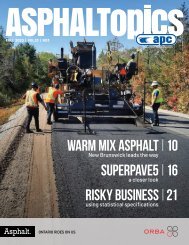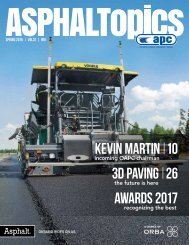ASPHALTopics | Summer 2014 | VOL 27 | NO3
Create successful ePaper yourself
Turn your PDF publications into a flip-book with our unique Google optimized e-Paper software.
26 OHMPA | ASPHALTOPICS<br />
HMA plant from the 1970s (Gencor)<br />
Milling machine from the 1970s<br />
getting the desired specified results,” he says. Loughnan<br />
says rubber rollers can now be equipped with propane<br />
heaters on the tires to lessen pickup on cooler days.<br />
Other key advancements for paving, according to<br />
Loughnan, include the hydraulically extendable screeds<br />
that were introduced in the 1970s to replace the old bolt-on<br />
extensions to the paver screed. This allowed for paving up<br />
to 24-feet in width and minimized the handwork required<br />
on variable width lanes and tapers.<br />
According to Doug Woods from Cope Construction and<br />
Contracting Inc., it’s the little things have led to innovation<br />
on the job. He says when he first started in the industry,<br />
diesel oil was used to coat the truck boxes and help the<br />
hot mix to slide out.<br />
“The old trucks weren’t made to specifically deal with the<br />
asphalt industry,” he says. “They had old steel boxes that<br />
were banged up with a lot of dents. To keep their truck<br />
boxes clean, the drivers had to climb into the truck box<br />
and brush on diesel fuel with the misconstrued concept<br />
that more would be better. Often there would be puddles<br />
of diesel fuel on the floor of the truck.<br />
In retrospect, he says, it was a bad process as the diesel<br />
oil would get mixed in with the hot mix asphalt and that<br />
would have affected the final product. “We didn’t have<br />
much choice back then though,” he continues. “If we<br />
didn’t use it there would be too much asphalt left stuck<br />
in the box.”<br />
Woods says the introduction of asphalt-friendly sprays,<br />
and trucks designed for the material, make that task<br />
easier, more efficient, and better for the pavement. As<br />
for advancements in paving, Woods believes the electronic<br />
controls on the equipment have been the biggest leaps<br />
in technology.<br />
“The controls on spreaders have improved the industry,”<br />
Woods says. “In the past, workers used to have to match<br />
curves visually. Now you can set the controls to manage<br />
the curves and the slopes. It’s all done automatically.”<br />
However, he adds, the changes have been more of a fine<br />
tuning instead of a complete overhaul. “If a company is<br />
forced to use a backup, they can still turn to equipment<br />
that is 15 to 20 years old,” he says. “It still works the same.<br />
Not too many industries outside of asphalt can do that.”<br />
Down the road, Woods predicts an age of even more<br />
precision for paving equipment, one where GPS devices<br />
and other technology will be relied upon rather than the<br />
skill of the crew. “It’s exciting, but kind of sad at the same<br />
time,” Woods says. “At one time, a company was known<br />
for its good operators, screed men and rakers. It was the<br />
calibre of the crew that made you proud of the industry.”<br />
Still, he knows competitive demands will push paving<br />
technology further and he is excited at the prospect<br />
of what the future has in store for the industry.<br />
Steve Pecar is a Mississauga-based writer,<br />
editor and designer.


















